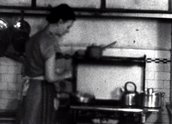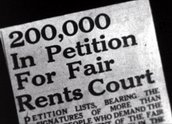

Take Notice (1939)
Synopsis
A silent, black-and-white documentary made by the Sydney Unity Film Group about unfair rent rises and the petition for a fair rents court.
Curator’s notes
Take Notice uses innovative and sophisticated filmmaking techniques to describe the need for a solution to rising rents and substandard living conditions in Sydney.
Using fast editing, dramatic camera angles, on-screen text and repetition of images, this style reflects the influence of 1920s Soviet filmmaker Sergei Eisenstein. Eisenstein used editing primarily for emotional or narrative impact rather than to construct the illusion of real action in real time.
Interspersed with images of daily life, real estate agents, housing conditions and petition signing are newspaper headlines that reinforce the messages behind the images. Aside from the newspaper headlines and final handwritten ending, there are no intertitles or explanations provided. Take Notice uses this unconventional approach to great effect, although it can be a little confusing and abstract for a contemporary viewer.
The film was made by Warwick Parkes, Paul Moline and Eddie Allison who all had links with Sydney’s New Theatre, which had its roots in the workers’ theatre and new theatre movements in Europe and the United States. Moline and Allison were also active members of the Communist Party of Australia, which had a strong affiliation with the New Theatre movement. The group formed the Sydney Unity Film Group to make Take Notice. Kit Parkes, Warwick’s wife, was also involved with the film and is thought to have done some of the editing. Many of the actors in the film were from the New Theatre. All three men were keen film buffs and Moline was an amateur photographer and subeditor at the Daily News. The production was a true collaborative effort with Parkes, Moline and Allison sharing the key creative roles. Most of the locations for the film are in the Northern beaches region of Sydney – including Manly and Balmoral beaches – as well as Milsons Point.
Moline and Parkes toured the film, screening it wherever they could – often in halls and tents. The filmmakers would pass a hat round to meet their costs and were met with a generous response, sometimes making a slight profit on their trip. According to Moline’s son, some of the halls used were probably hired venues to raise funds for the Communist Party (which was banned at the time) through the State Labor Party. The film was also possibly shown at an open-air State Labor Party conference in January 1941. In the 1930s, Parkes and Moline both had young families and were renting in the increasingly high-priced rental market in Sydney – so Take Notice was as much a personal project as it was a political indictment of the inadequate housing situation.
It wasn’t until well into the 1940s and 1950s that postwar building schemes began to alleviate some of the problems. For an example of one of these schemes see A Home of their Own, made in 1949 by the Housing Commission of Victoria.
- Overview
- Curator’s notes
- Video 2 clips
- Principal credits
- Find a copy
- Comments 2
- Map
- Add your review



